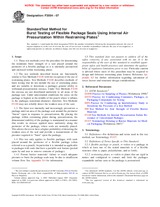Potrebujeme váš súhlas na využitie jednotlivých dát, aby sa vám okrem iného mohli ukazovať informácie týkajúce sa vašich záujmov. Súhlas udelíte kliknutím na tlačidlo „OK“.
ASTM F2054-07
Standard Test Method for Burst Testing of Flexible Package Seals Using Internal Air Pressurization Within Restraining Plates
Automaticky preložený názov:
Štandardná skúšobná metóda pre roztrhnutie testovanie Flexibilné balíčka pečaťou používanie vnútorné ovzdušie natlakovanie Vnútri znehybňovacích Dosky
NORMA vydaná dňa 1.8.2007
Informácie o norme:
Označenie normy: ASTM F2054-07
Poznámka: NEPLATNÁ
Dátum vydania normy: 1.8.2007
Kód tovaru: NS-52615
Počet strán: 8
Približná hmotnosť: 24 g (0.05 libier)
Krajina: Americká technická norma
Kategória: Technické normy ASTM
Anotácia textu normy ASTM F2054-07 :
Keywords:
burst, closed-package, flexible packaging, inflation, medical packaging, open package, restraining plate method, ICS Number Code 55.040 (Packaging materials and accessories)
Doplňujúce informácie
| Significance and Use | ||||||||||||
|
This test provides a rapid means of evaluating tendencies for package seal failure when the package is exposed to a pressure differential. Pressure differentials may occur during such processes as sterilization and transportation. This test method provides an indicator of the burst strength of a package, where the burst will normally occur in one or more areas of the seal. An indicator of the minimum burst strength may be of importance to the package manufacturer and end user in ensuring adequate package integrity. This test method cannot provide a measure of package seal uniformity. This test method also cannot provide an evaluation of overall package integrity or the burst strength of areas of the package that contact the surface of the restraining plates used. This test method should be combined with other methods of evaluating overall package integrity, uniformity of the package seal, or opening functionality, if so required. This test frequently is used to quickly evaluate package seal strength during the manufacturing process and at various stages of the package’life cycle. If correlations between pieces of test equipment are to be made it is important that all parameters of the test be equivalent. Typical parameters can include, but are not limited to the package size, material, type and configuration of seal, rate of air flow into the package, pressure detection sensing mechanism and sensitivity (machine response to pressure drop), position of test article, rigidity of restraining plates, and distance between restraining plates. See Appendix X2 for further information. This test may not necessarily provide correlation with package seal strength as typically measured using Test Methods F 1140 or F 88 (or equivalents). |
||||||||||||
| 1. Scope | ||||||||||||
|
1.1 These test methods cover the procedure for determining the minimum burst strength of a seal placed around the perimeter of a flexible package as it is internally pressurized and enclosed within restraining plates. 1.2 The test methods described herein are functionally similar to Test Methods F 1140 with the exception of the use of restraining plates. Test Methods F 1140 describes methods of burst testing that do not include the use of restraining plates and are suitable to determine a packages general ability to withstand pressurization stresses. Under Test Methods F 1140 the stresses are not distributed uniformly to all areas of the package seal. Under unrestrained conditions the stress on the package is highest at the middle of the pouch where it inflates to the packages maximum diameter; therefore, Test Methods F 1140 may not reliably detect the weakest area of the seal. 1.3 The burst test internally and increasingly pressurizes a package until an area of the package seal around the perimeter "bursts" open in response to pressurization. By placing the package within restraining plates during pressurization, the dimensional stability of the package is maintained in a manner that results in stresses applied more uniformly along the perimeter of the package, where seals are normally placed. This allows the test to have a higher probability of detecting the weakest area of the seal and provide a measurement of the pressure required to "burst" open the package. 1.4 This test only applies to flexible packages with seals placed around the perimeter of a flexible package (often referred to as a pouch). In particular it is intended as applicable to packages with seals that have a peelable seal feature (peeled open by end user to remove contents of package). 1.4.1 Porous barrier materials' failure to reach adequate pressure to burst the package seals may be due to insufficient volume flow. See Appendix X4 for information. This standard does not purport to address all of the safety concerns, if any, associated with its use. It is the responsibility of the user of this standard to establish appropriate safety and health practices and determine the applicability of regulatory limitations prior to use. Particular caution is advised where users of this procedure may be required to design and fabricate restraining plate fixtures. Reference Appendix X3 for further information regarding calculation of stress factors and structural design considerations. |
||||||||||||
| 2. Referenced Documents | ||||||||||||
|
Odporúčame:
Aktualizácia technických noriem
Chcete mať istotu, že používate len platné technické normy?
Ponúkame Vám riešenie, ktoré Vám zaistí mesačný prehľad o aktuálnosti noriem, ktoré používate.
Chcete vedieť viac informácií ? Pozrite sa na túto stránku.




 Cookies
Cookies
